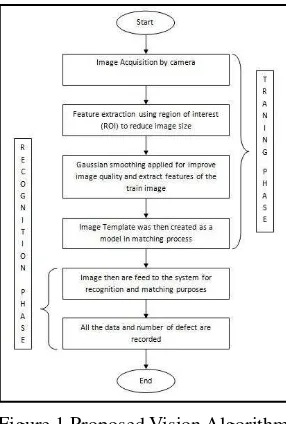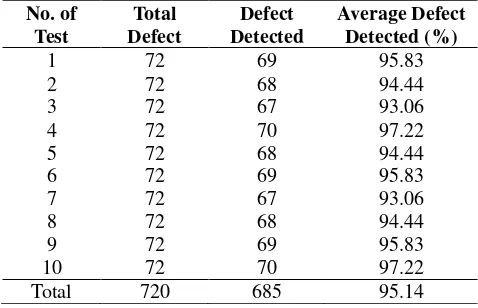Proceedings of Mechanical Engineering Research Day 2015, pp. 83-84, March 2015
__________
© Centre for Advanced Research on Energy
Application of defect detection in gluing line using shape-based
matching approach
Mohamad Haniff Harun1,*, Khalil Azha Mohd Annuar1, Aminurrashid Noordin1, Mohd Hanif Che Hasan1, Muhammad Salihin Saealal1, Mohd Firdaus Mohd Ab Halim1, Muhammad Fareq Ibrahim1
1) Faculty of Technology Engineering, Universiti Teknikal Malaysia Melaka,
Hang Tuah Jaya, 76100 Durian Tunggal, Melaka, Malaysia.
*Corresponding e-mail: [email protected]
Keywords: Shape-based matching; region of interest; matching process; template matching; correlation.
ABSTRACT – This paper investigates various
approaches for automated inspection of gluing process using shape-based matching application. A new supervised defect detection approach to detect gap defect, bumper defect and bubble defect in gluing application is proposed. The creation of region of interest for important region of the object is further explained. The Correlation algorithm to determine better image processing result using template matching techniques is also proposed. This technique does not only reduce execution time, but also produce high accuracy in defect detection rate. The recognition efficiency will achieve more than 95% with defect’s data for further process.
1. INTRODUCTION
Vision-based inspection of industrial products offers low-cost, high-speed, and high-quality detection of defects. One of the most challenging industrial inspection problems is dealing with the textured of the gluing process. Defects often happen during gluing process. To ensure that only quality units are produced, defects detection and recognition system commonly are installed for segregation of the defects unit. There are many techniques that provide a solution in recognizing image or object in image processing such as region [1], edge-based features [2], feature extraction [3], shape context [4], Gaussian Curve [5] and etc. Other researches were based on HALCON Application for Shape-Based Matching [6-8]. The researches discussed about the process involved in basic shape based matching algorithm together with Extended Region of Interest (ROI) function available in HALCON that fulfils shape based matching to find object based on a single model image with sub pixel accuracy. The basic concept of defect matching using shape-based matching algorithm based on Extended Region of Interest introduced by [9].
In this paper, an improve filter method that uses a computer to automatically recognize the gluing defects is put forward. In this approach, the digital image of the gluing defects is binarized first. Then ROI is further process before. Correlation algorithm refines the image. Once the importance feature of the binarized image has been extracted, the features are trained for defect classification. To better understand this method, in the next section, each kind of defects is elaborated further.
ROI is applied to reduce processing time. Then depending on the features classification of the defect, feature extraction and Gaussian smoothing are used.
2. METHODOLOGY
Shape-based matching application is divided into two phases, Training phase and Recognition phase as shown in figure 1. Training phase is important in identifying the defect correctly. If the usage of the specific data are not optimize, the result will not be as accurate as what we desired. Hence, defect matching results with high accuracy and precision depends on the best reference image transformation. Matching phase is used to find similarity between reference images and tested images. Similarity is classified as recognition rate. Higher recognition rate means the systems proposed are effective and optimize. This application is easier to process because it reduce the region known as Region of Interest chosen by the users. Processing time can also reduce apart from producing higher recognition rate.
Figure 1 Proposed Vision Algorithm
Harun et al., 2015
84 the average gray level of source image, ẏ are compared to the square root summation of the pixel differences between two images. Correlation value is between -1 and +1, with larger values representing a stronger relationship between the two images. Figure 2 and equation 1 shows the correlation relationship.
Figure 2 Template Matching Process Evaluation
��� = ∑�−�= �− ẋ • �− ẏ √∑�−�= �− ẋ • ∑�−�= �− ẏ
(1)
Where N = template image size = column x row
Correlation value totally depends on template creation throughout the system. Without proper contribution on it, may result to poor recognition rate. The important of ROI extraction method that delivers the precise region helps in findings the same object from various types of images.
3. RESULTS AND DISCUSSION
The potential of the proposed visual algorithm system was the flexibility of the program to accommodate changes. 10 images are being tested repeatedly for 10 times for its flexibility in determining all defects occur in the tested images. The tested images are filled with all the three defects models that are already being trained in training phase and fed into the system for recognition purposes.
Table 1 Recognition Rate for Proposed Defect Inspection System
Table 1 shows the result of defect matching by using 10 tested. According to the results, the recognition rate of the experiment is about 95.14% based on 3 model defects created through the system. This result is compared with [10] where it considered the problem in
detecting welding defects in welding lines where the past researchers put an effort on more complex algorithm or limited in efficiency.
Table 2 Comparison of Results
Weld Defect
500 samples 720 samples
No. of Types 6 types 3 types research with strong application background. In this paper, a method that is used to extract features of defects and auto recognizes defects are put forward. Experimental results show that the recognition rate achieved about 95.14% which is much better for acquiring defect detection in gluing lines.
5. REFERENCES
[1] L. W. Teck, et al., "Flexible approach for Region of Interest creation for shape-based matching in vision system", 2010, pp. 205-208.
[2] C. Gu, et al., "Recognition using regions," 2009 [3] D. Naso, et al., "A fuzzy-logic based optical sensor
for online weld defect-detection," Industrial Informatics, IEEE Transactions on, vol. 1, pp. 259-273, 2005.
[4] A. C. Berg, et al., "Shape matching and object recognition using low distortion correspondences," 2005.
[5] X. Xie, "A review of recent advances in surface defect detection using texture analysis techniques," Electronic Letters on Computer Vision and Image Analysis, vol. 7, 2008, pp. 1–22.
[6] Sulaiman, M., M. Shah, et al. "A 3D Gluing Defect Inspection System Using Shape-Based Matching Application from Two Cameras." International Review on Computers & Software 8(8), 2013, pp. 1997-2004.
[7] Sulaiman, M., H. N. M. Shah, et al. "Defect Inspection System For Shape-Based Matching Using Two Cameras." Journal of Theoretical & Applied Information Technology 61(2), 2014, pp. 288-297
[8] L. Teck, et al., "Implementation of Shape–Based Matching Vision System in Flexible Manufacturing System," Journal of Engineering Science and Technology Review, vol. 3, pp. 128-135, 2010.
[9] X. Xu, et al., "HALCON application for shape-based matching," 2008, pp. 2431-2434.
[10] J. Peng, "A method for recognition of defects in welding lines," International Conference on
Artificial Intelligence and Computational

